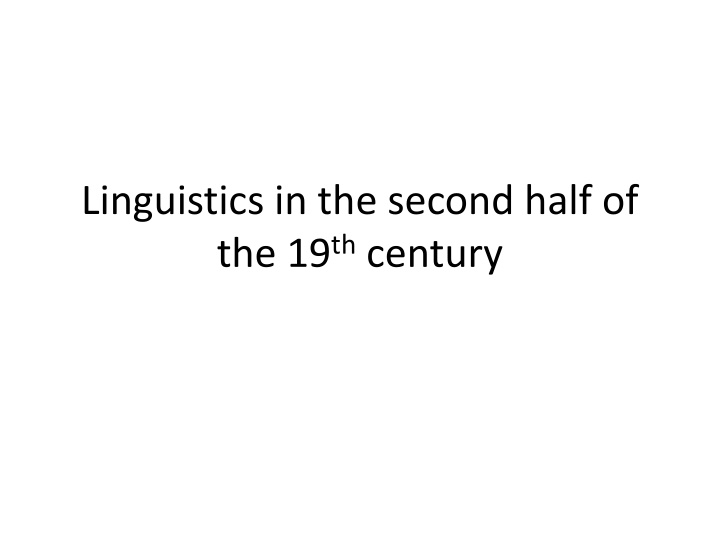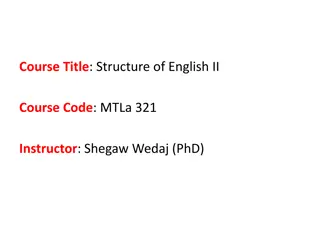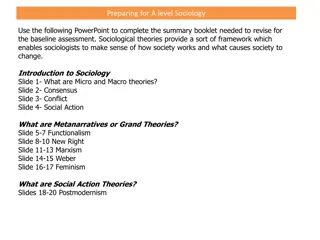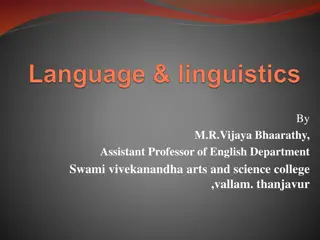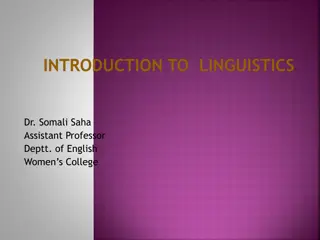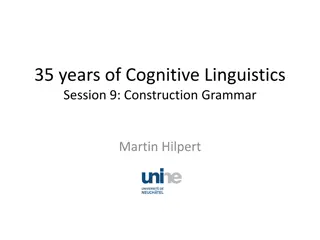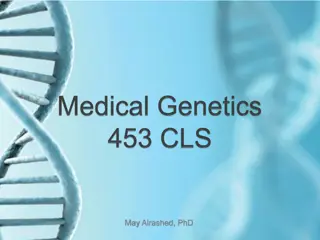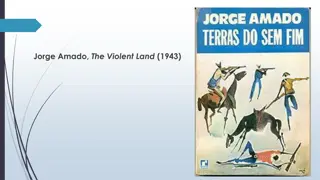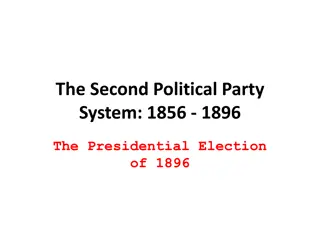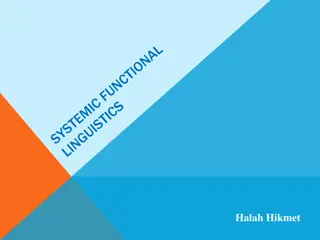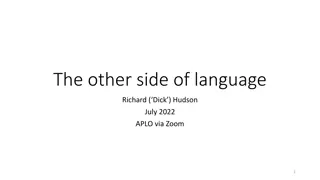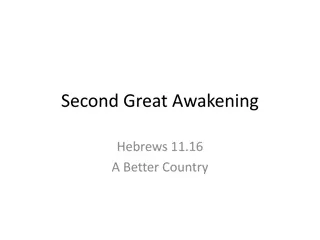Linguistics in the Second Half of the 19th Century: Schleicher, Psycholinguistics, Neogrammarian Theories
August Schleicher's biological approach to language, including his Stammbaumtheorie, aligned with Darwinian ideas prevalent in the 19th century. The origins of psycholinguistics can be traced back to Heymann Steinthal, who advanced the psychology of language. This period saw critical developments in linguistic philosophy, comparative grammar of Indo-European languages, and neogrammarian theories. The intersection of linguistics and natural sciences, influenced by Darwin's theory of evolution, marked a significant era in the study of language and its historical evolution.
Download Presentation

Please find below an Image/Link to download the presentation.
The content on the website is provided AS IS for your information and personal use only. It may not be sold, licensed, or shared on other websites without obtaining consent from the author.If you encounter any issues during the download, it is possible that the publisher has removed the file from their server.
You are allowed to download the files provided on this website for personal or commercial use, subject to the condition that they are used lawfully. All files are the property of their respective owners.
The content on the website is provided AS IS for your information and personal use only. It may not be sold, licensed, or shared on other websites without obtaining consent from the author.
E N D
Presentation Transcript
Linguistics in the second half of the 19thcentury
Linguistics in the second half of the 19thcentury 1. August Schleicher s biological approach to language. 2. Origins of psycholinguistics. 3. Alexander Potebnja s philosophy of language. 4. Neogrammarian theories.
August Schleichers biological approach to language August Schleicher (1821-1868), German linguist A Compendium of the Comparative Grammar of the Indo-European Languages Subtitle: Outline of a phonology and morphology of the Indogermanic parent language
August Schleichers biological approach to language August Schleicher s Stammbaumtheorie (genealogical tree model) Criticism: a very literal presentation of language history languages do not sharply split at a given point at a time the split is not complete, as certain sets of features are shared by different groups of languages within one family it suggests that dialectal divisions are the most recent feature of linguistic history, since dialects occur at the end points of the tree
August Schleichers biological approach to language Biological nature of August Schleicher s Stammbaumtheorie It was in line with Darwinian ideas prevalent in the second half of the 19thc. In 1863 Schleicher published a short treatise on Darwinian theory and linguistics: He regarded himself as a natural scientist and language as one of the natural organisms of the world. Independently of its speakers will or consciousness, a language has its periods of growth, maturity and decline. Darwin s theory worked out for animal and vegetable kingdoms was broadly appropriate for linguistic history. Diffusion of languages over the earth s surface, their contacts and conflicts are similar to animals struggle for existence. In this struggle the Indo-European languages were victorious.
Origins of psycholinguistics Heymann Steinthal (1823 1889) inventor of the psychology of language professor in general linguistics and in biblical exegesis, Berlin Felicitous advances in linguistics presuppose an advanced psychology. 1871 Introduction to psychology and linguistics
Origins of psycholinguistics Heymann Steinthal In just the same way as any embryo builds this or that organ during a particular phase of its development, at some definite point the mind necessarily builds language, today, as in the primeval era. Linguistics can only be psychological
Origins of psycholinguistics Heymann Steinthal: The study of apperception is the main task of psychology. psychological subject, idea in the speaker s mind Apperception is a two-sided process: (apperceiving element) second idea, psychological predicate (that which is apperceived) Apperception - comprehending (a new idea) by assimilation with the sum of one's previous knowledge and experience.
Origins of psycholinguistics Heymann Steinthal specified the notion of Humboldt s inner language form: it is the bond between speech sound and signified. How does sound become bound to the signified? It is possible because some members of the mass of old perceptions hold something in common with the new perception. This common element unites the new with the old and as inner language form becomes the actual content of the sound complex. Thus: sound - embodiment of thought inner language form manner of embodiment
Origins of psycholinguistics Heymann Steinthal In the civilized language user practically any idea is a word-idea. Any idea in consciousness is just the abstract reference of a word to its unconscious meaning complex. This internal speech form has little or no content. For the speaker it is no more than a sign in consciousness, which got there through activation by the always active underlying, unconscious meaning complex. For the hearer it is also the conscious word sign, which can activate the same underlying apperceptive mass, which is, psychologically, the word s meaning.
Origins of psycholinguistics Wilhelm Wundt s (1832 1920) ethnic psychology Volkerpsychologie addresses the higher mental processes from the point of view of their cultural products, such as language, myth, and custom. The evolution of these complex cultural phenomena, according to Wundt, reflects the evolution of human consciousness.
Origins of psycholinguistics Wilhelm Wundt Language, whether spoken, gestural, or written, is an expressive movement, which can serve the intention of communicating thoughts, feelings and inner states. Children s acquisition of the language: Not a single word could be identified as independently invented by the child. A child ignorantly imitates words from his environment before he attaches any meaning to them ( echo speech ). After all, children s speech is a product of the child s environment, in which the child itself is, essentially, only passively involved.
Origins of psycholinguistics Wilhelm Wundt Origins of ongoing new word formations: the slang of students, the technical terms of scholars, sound and word reduplication ( mama , bonbon ) word compounding ( household ). NO AFFIXATION Innovative syntactic perspective: When you speak, you start building a sentence from a total image ( Gesamtvorstellung ), which you then successively analyze into smaller images or concepts that go with words.
Alexander Potebnjas philosophy of language. Alexander Potebnja (1835-1891) - Ukrainian philosopher and linguist, professor of linguistics at the University of Kharkov (1862) (1864) (1874) (1895) Major fields of linguistic work: the philosophy of language the historical phonetics of the East Slavic languages, etymology Slavic historical syntax.
Alexander Potebnjas philosophy of language. Alexander Potebnja Language is the means by which the mind orders the influx of impressions and stimuli. Words carry not only a meaning, but also the past experience of the individual and the nation, through which all new experience is filtered. Thus a word usually has three aspects: an external form, a meaning, and an internal form. It is through the internal form that the objective world is subjectivized. In many cases the internal form is rooted in myth and, hence, acts as a bridge between language and folklore (with its symbols).
Neogrammarian theories The Neogrammarians (also Young Grammarians; German: Junggrammatiker) were a German school of linguists, originally at the University of Leipzig, in the late 19th century.
Neogrammarian theories The essence of Neogrammarian theory was set forth in an article in a journal founded by its two major proponents, Herman Osthoff and Karl Brugmann: all sound changes as mechanical processes take place according to laws that admit no exceptions within the same dialect (Verner s law that resolved the exception to Grimm s law) the same sound will in the same environment always develop in the same way BUT: analogical creations and reformations of specific words are equally a universal component of linguistic change
Neogrammarian theories Existence of comparative and historical linguistics as a science rested on the assumption of regularity of sound change. The history of a language is traced through recorded variations in the forms and meanings of its words . Languages are proved to be related if they have words bearing formal and semantic correspondences which can not be explained by mere chance or recent borrowing. If sound change were not regular and correspondences not reliable linguistic relations could only be established historically, by extralinguistic evidence (Romance languages)
Neogrammarian theories Opposed the theory of language growth, maturity and decline. Scientific treatment of a language can only be historical treatment. Drew attention away from the Ursprache as a prehistoric reality to the data of written records and contemporary spoken languages. IE forms (*) are formulae rather than actual words
Neogrammarian theories Deficiencies of neogrammarian theory: Humboldt s structural conception of language (innere Sprachform) found no place in their theory, thus the object of investigation was reduced from the language system to idiolect (language localized in an individual) restricted themselves to description of surface phenomena (sound level)
Neogrammarian theories Influence gave a powerful impetus to the development of phonetics (never again confusing written letter with spoken sound) encouraged earnest studies of living dialects, publication of dialect atlases drew attention to linguistic borrowing as a universal feature in the history of language and the study of loan-words drew attention to analogy as an ever present tendency in language development
Neogrammarian theories Criticism (mainly from specialists in dialectology and linguistic geography) geographical dialect divisions are in constant fluctuation and are not clear-cut where is the line beyond which a dialect becomes an idiolect? why do some words change before others where the same sounds are involved? many individuals carry more than one social and regional dialect many unpredictable factors interfere with the expected sound change (homonymy, false etymology, similarity with taboo- words, social prestige, etc.)
